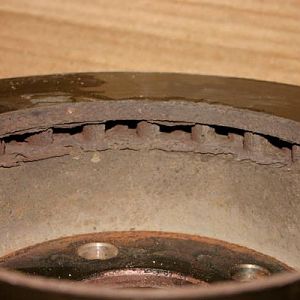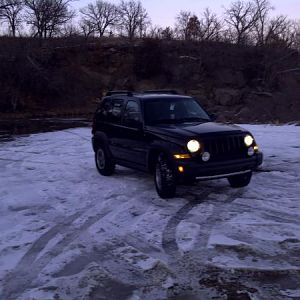No need to reply, I have found the answer. Renault 5 thermostat.
sferg410:
Any thermostat valve stuffed in the upper radiator hose is a very bad idea, for the following reasons...
THE FOLLOWING 3 FACTS SHOULD BE CAREFULLY CONSIDERED BEFORE CONTEMPLATING A COMMON AND SHORT-SIGHTED “FIX” FOR FAILED THERMOSTAT ASSEMBLIES IN V.M. MOTORI R425 AND R428 ENGINES, WHICH IS THE INSTALLATION OF ANOTHER THERMOSTAT VALVE IN THE UPPER RADIATOR HOSE. WHILE IT IS APPEALING THAT THIS SHORT-CUT IS SO INEXPENSIVE, YOU WILL LIKELY CAUSE A GREAT DEAL OF DAMAGE TO YOUR ENGINE OVER A PERIOD OF TIME BY MAKING CHANGES TO HOW THE COOLING SYSTEM OPERATES IN WAYS NEVER INTENDED BY THE DESIGNERS OF THESE ENGINES.
1) The thermostat you stick in the upper radiator hose is designed to regulate engine temperatures on a smaller, lighter engine designed to make a lot less power and do less work. The heat created in the Renault engine is far less than the heat created in the 2.5L or 2.8L CRD engines and therefore the Renault has a much smaller cooling system with a significantly smaller thermostat valve designed for it. In situations where you are working your CRD engine very hard, it will likely NOT flow the engine coolant you need to keep the engine temperatures down.
2) The inline thermostat valve is quite a distance away from the coolant outlet at the cylinder head. There is a question of accuracy with which the inline valve can control engine temperatures as there is some cooling of the engine coolant after it leaves the cylinder head and before it can reach the valve. Therefore, if the valve is designed to open up at 195 degrees Fahrenheit, the engine is going to be hotter than that opening temperature. This inaccuracy creates another risk of overheat situations occurring.
3) The greatest problem that occurs with this specific situation, (addition of a second thermostat valve controlling coolant flow through the radiator circuit on a V.M. Motori R425 and R428 engine), is that it creates a situation where there are times during operation of the engine that you have NO coolant flow through the engine. Over a long period of time, this can lead to the cylinder head warping and cylinder head gasket failure. Read further for a detailed explanation of this…
ALL LIQUID COOLED INTERNAL COMBUSTION ENGINES HAVE BYPASS CIRCUITS IN THEIR COOLING SYSTEM. These circuits were deemed necessary at least a century ago because it was determined that coolant must always be circulating around inside the engine to keep hot spots from forming, typically around the exhaust ports in the cylinder head.
A very simple 1-circuit liquid cooling system without a thermostat valve accomplishes this, because there is no valve to stop coolant flow. The problem with this simple system is that it over-cools the engine; the results of which are poor fuel economy, a build-up of contaminants in the engine oil, and a shorter engine life. Thermostat valves were developed to properly regulate engine temperature, but then the engines started to have all kinds of cylinder head gasket failures and warped cylinder heads.
Some automotive engineer all those years ago figured out that a second cooling system circuit can be added to the engine; one which has the same coolant pathways in the engine block and cylinder head(s), but one that loops back on itself and “bypasses” the radiator…. Hence the name “bypass circuit”. With the addition of a bypass circuit you now have a cooling system that flows coolant throughout the engine at all times; either through the radiator circuit or the bypass circuit, or both circuits.
Old engines typically had a low power-to-displacement ratio, and it was O.K. to have an open bypass circuit. This was because these engines did not create enough heat, (due to their low power output), to overwhelm the cooling system even when the engine was worked hard and some coolant bled off through the open bypass circuit rather than going through the radiator circuit.
On the other hand, modern engines like the R428 have a much higher power-to-displacement ratio, and can create tremendous heat that must be shed off to prevent overheat situations from occurring. These engines must have more efficient cooling systems, and therefore typically have a valve controlled bypass circuit. Valve controlled bypass circuits increase cooling system efficiency because the bypass circuit is shut off when there is heavy demand placed on the engine… ALL the coolant is forced through the radiator circuit where it can have maximum heat shedding ability.
Typically, a cooling system that has a valve controlled bypass uses a thermostat valve where the wax motor, (AKA a heat motor or wax pellet, as some might refer to it), has a radiator circuit valve on one end, and a spring-loaded bypass valve on the other end. The operation of this valve is very simple; when one valve on one end is stroking open, the other is stroking closed by default. With this design, it is not possible to shut down coolant flow throughout the engine because one or the other circuit is open…. coolant is – under all circumstances – continually flowing around the engine to keep engine temperatures EVEN. The Jeep Liberty/Cherokee CRD engine has this design thermostat valve in its thermostat assembly.
Furthermore, it is well known that thermostat valves are designed to fail OPEN; and by this I mean that the valve controlling coolant flow to the radiator will fail open. This is deliberately designed for the rather obvious reason that if the valve controlling flow to the radiator were to fail closed, then the driver would experience a serious overheat situation and a possible boil-over of the cooling system, with possible serious damage occurring to the engine.
The above information is not in dispute, and anyone can take a little time and easily research this for themselves.
Consider then what would happen if a thermostat valve with a spring loaded bypass valve were to fail; the main valve controlling coolant flow to the radiator would fail open, and the BYPASS VALVE WOULD FAIL CLOSED BY DEFAULT. In effect, your entire cooling system bypass circuit would be shut down, but you would still have necessary coolant flow throughout your engine because the radiator circuit is now open all of the time.
If your O.E. type thermostat assembly is starting to fail or has completely failed – as indicated by your engine running cooler and cooler with the resultant loss of fuel efficiency and long-term reliability problems – and you then decide to be cheap and install an inline thermostat in whatever form they may come in, ANY TIME that inline thermostat valve is closed, (like during warm-up of your engine or often during operation in very cold climates), you will have virtually NO coolant flow throughout the engine. Hot spots will start to form in your cylinder head or heads; right around the exhaust ports as this is always the hottest part of the engine. Your cylinder head or heads will warp over time and you will have a head gasket failure.
ADDENDUM
It is no surprise to me and other CRD owners who think like me that the damages that can occur to CRD engines as a result of installing an inline thermostat of any type are precisely the SAME damages that are complained about most often by people online in this forum and in other forums.
The CRD engine is a consumer grade diesel engine with its aluminum head/iron block architecture and timing belt design. Aside from the higher service costs of changing out the timing belt every 100,000 miles or so, designing an engine this way practically guarantees a limited service life verses a similar diesel engine that has iron head/iron block architecture with gear driven cams.
All aluminum head/iron block engines are subject to more frequent head gasket failures and head warpage because of the fact that aluminum has almost 2 times the thermal expansion factor of iron. This is especially true of consumer grade diesel engines due to their high compression ratios and use of turbochargers. If this is common knowledge, why in **** would anyone mess with the design and function of the CRD engine cooling system and risk creating hot spots in the cylinder head, right around the exhaust ports?
For those new Liberty CRD owners who are only now finding out the problems associated with our little tractors, there is a high propensity of the following problems… head gasket failures, cylinder heads warping and/or cracking, engines eating exhaust valves and ceramic glow plugs cracking with pieces falling into the engine. These are all problems that are far more prevalent when you have a cooling system that does not have a functioning bypass circuit with a second independent thermostat valve controlling flow to the radiator.










